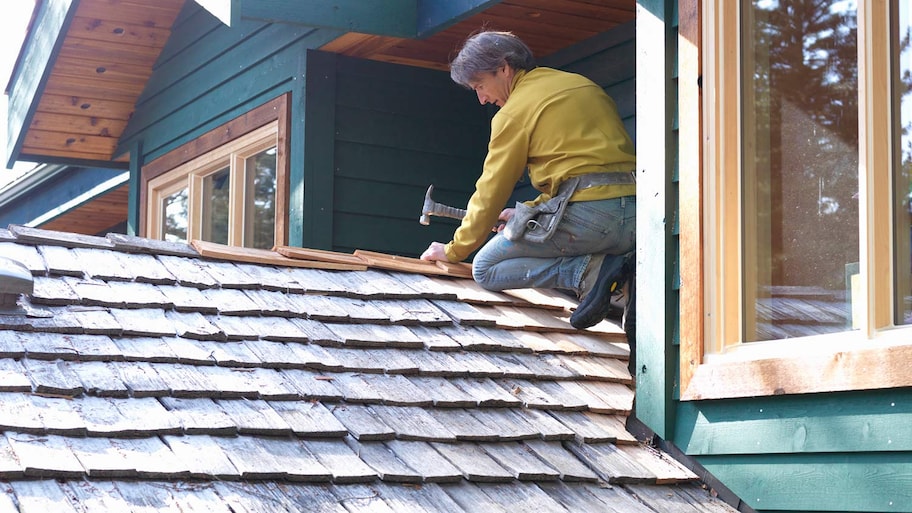Take care of the roof over your head
Actively dripping water and flying shingles is hardly the time to brainstorm your emergency roof response plan. When the top of your home needs attention, you must act fast. That’s why it’s so important to know how to care for your roof in case of an emergency. Follow these tips and you’ll become the emergency roof repair expert you never knew you needed.
1. Place a Tarp to Prevent Leaks
Water seeping into your home from above is a definite roofing emergency that requires immediate action to prevent additional cosmetic or structural problems. Affix a temporary tarp to the surface until a professional can come and evaluate the situation. Pull the tarp tightly down onto the roof and smooth it out. Make sure the tarp is tucked under the roofing material or installed up and over a ridge, to prevent the water from enterting at the top and running underneath. Then, nail down the edges and cover the nail heads with roofing cement.
Make sure the tarp is large enough to cover the entire affected area and that the tarp is meant for outdoor usage.
2. Repair Damaged Shingles and Tighten Loose Ones
Most of the time when leaks are caused by loose or damaged shingles, you can tackle a temporary fix while waiting for the pros. Reaffix loose shingles, as well as the surrounding shingles using adhesive, cement, or roofing nails around the edges.
Record and note the shingles you’ve band-aided so that you can share that info with the pro once they arrive.
3. Don’t Tackle The Big Stuff Yourself
It’s hard not to gravitate toward the DIY lifestyle, but there are some jobs that are just too dangerous for amateurs to tackle solo. Making serious repairs to your roof is one of them. Call a local roof repair company to fix significant roof damage such as missing flashing, roof rot, or water spots on your ceiling. Even better, you won’t have to lug and climb a ladder.
4. Document the Damage
Just because you shouldn’t grab a ladder and climb up on your damaged roof, doesn’t mean you can’t take action as soon as you see there’s damage.
Snap “after” photos and videos of the damage
Document in writing what you believe to be the extent of the damage
Record any estimates, invoices, and bills you receive
Having all of this information on file will help ensure a smooth and hassle-free claims process.
5. Contact Your Insurance Company
Reach out to your insurance company and describe the damage to your roof. Find out what your policy covers and whether insurance will cover partial or full costs for repair. Your insurance company will likely send an inspector to your home to investigate and verify your claim.
“Often insurance companies want you to have a roofing contractor look at the damage so that you don't open up a claim unnecessarily, which can hurt your ratings with your insurance carrier,” says Ami Feller of Feller Roofing. “If your contractor thinks you might have a roof claim, it can be very beneficial to have your contractor present when your insurance adjuster comes—it avoids a lot of back and forth. The two can assess the damages together and hopefully come to an agreement on the spot about what needs to be done to repair the roof.”

Signs of a Roof Leak You Need To Know
Before your leaking roof becomes a serious problem there are often common indicators that your roof is in disrepair:
Water spots
Missing or damaged shingles
Missing or damaged flashing
Water spots or wet roof decking
Common Conditions That Can Spark a Roofing Emergency
While it’s tough to predict when roof damage will occur, there are a few common culprits for roof repair emergencies. Knowing what they are can help you prepare and act should your roof become compromised.
Weather: Wind above 50 mph is strong enough to pull shingles off your roof and drive flying branches right through the roofline if the conditions are fierce enough. Lightning that strikes your house can burn a hole right through your roof. Inspect your roof after a severe storm to make sure that it’s properly intact.
Fire: Even an isolated fire in your home that’s quickly extinguished can cause damage to your roof. If your home has experienced a fire, small or big, it’s important that you have a roofing professional in your area come out and evaluate your roof.
Animals: Squirrels are darn cute when they are begging for a peanut at the park, but a nest of them in your attic chewing holes through your roof is anything but adorable. Regularly inspect your attic and gutters to make sure you don’t have any critters making a home for themselves in your indoor space!
FAQs
How do you temporarily patch repair a roof?
For a quick and temporary roof repair, you can patch over a leaky area using spray foam. If the area you’re spraying the foam over is wet, the water will still leak through to your home. A more effective temporary fix is to remove the wet area, replace it with dry material, then spray the foam. You can also cover damaged areas with polyethylene plastic sheets, waterproof tarps, or tar paper. You can also close up small leaks using roofing tape. Again, these methods are temporary solutions to hold you over while you wait for permanent repairs.
Can you patch a roof without replacing it?
It is possible to patch a damaged area of a roof without replacing the entire thing. You can opt for roof repairs instead of replacement if the damage only affects a small area or your roof, or if your roof is fairly new. Shingles, in particular, are relatively easy to replace if they suffer damage during a storm. In general, you should consider replacing your roof if more than 30% of it is damaged.
Will Flex Seal work on a roof?
Flex Seal is a brand of liquid rubber sealant, and yes, you can apply it on a roof to temporarily stop leaks. Although effective as a quick fix, it’s a temporary solution. It’s best to call a roof repair specialist to for a permanent fix.





